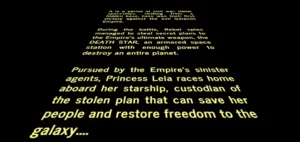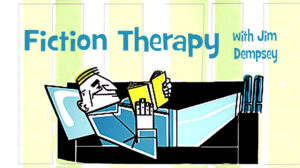Editing
When you walk into a room, whether you are at a conference hoping to win a big award, picking up a pizza, or on a first date – you are the star of the show playing out in your mind.
You see the world from your own unique perspective and are acting in accordance with your own desires.
The same can be said about the main character in that scene you are struggling to get right. Experimenting with the point of view might help you get unstuck.
When I get frustrated with a scene I’m working on, if it’s feeling flat or lacking tension or spark, I allow myself to break out of the point of view in which I’ve chosen to write.
Let’s try a thought experiment. Imagine you are in that ballroom filled with your peers, other writers. You have been nominated for a big award and the winners are about to be announced.
Your ambition got you in that room. Your desires govern what you hope will happen. Your fears dictate how you act (or don’t act.) You are the center of the action, the one under the spotlight. Everything you see, think, and feel is influenced by everything that has ever happened to you leading up to this moment.
Are you flashing back to high school when you were a runner-up, but not the winner, for an academic prize? Are you privately grumbling because you are up against your nemesis who always edges you out? Are you afraid you will cry if you don’t win? Are you worried you will trip on the way to the podium if you do win? Are you hoping to win because you want to rub it in the face of your ex, who also happens to be nominated for this award?
Now freeze the frame.
Look around the imaginary table where you are sitting.
Every single person in that scene believes they are the center of the story. And their internal dramas have nothing to do with yours. The waiter might be concerned about being late getting home for the babysitter – again. They can’t risk losing this sitter, but their boss doesn’t give a crap. The smiling author at the table next to you is bereft because it’s been three years since she has been nominated for anything. Her husband next to her is bored out of his mind and is secretly listening to a horse race, which he bet a lot of money on. Maybe this one will pay off and he won’t have to tell his famous author wife he took out a second mortgage to pay off his gambling debts.
Everyone in the room is experiencing that same scene – the awards ceremony – through a different filter colored by their individual circumstances and experiences. Every person in that room wants something. And, for the most part, none of their desires have anything to do with you.
This thought experiment – recognizing that everyone in the room thinks they are the center of the story – makes for a helpful writing exercise, especially for those pesky scenes that just feel off, where the tension falls flat.
Step One: Make a map. Just as you did in that imaginary awards ceremony, I want you to enter […]
Read MoreOne thing you’re bound to deal with when you pursue publication is editorial feedback. Either from beta readers, critique partners, or professional editors. It’s been more than a decade, but every time I get a feedback email (no matter how lovingly written) I STILL sit there in sheer terror for minutes/hours/days, before I can bring myself to read it. Can you relate?
In the end, it benefits me more than anyone else to actually read the feedback, make sense of it, and push past my fear of messing up. Here’s how I handle it:
Not when I’ve had a bad day, I’m stressed or I’m tired. I like to remind myself that the people sending me feedback are people I respect, and I asked for their opinion. Their job is to help me tell the story I’m trying to tell in the best way, and they’ve lovingly used their time to go through my story to help me.
I let things marinate in my head, and think about which points are valid and which are not. If I’m having a strong emotional reaction to a piece of feedback, I need to think about why. If I want to reject a piece of feedback, that’s okay too, but I also need to know why.
BUT remember that even though someone points out something is wrong, they may not know the real reason, or how to fix it. That’s up to you to figure out.
Each list depends on what editorial feedback I received. I cut and paste all the points raised into lists in a new document. When I’m done, I have several pages of concrete things I need to fix in the novel. I cross each one off as I fix it in the manuscript, so I can track whether or not I’ve addressed all the issues I needed to.
An example of list categories:
I like to create a simple spreadsheet after I complete the first draft of a novel, and in each row, I’ll write down one sentence description for each scene in the book, numbered by chapter and scene. For ex. 5-1 = Chapter 5, Scene 1. This helps me find all the places where I need to fix things, and when things […]
Read MoreFrom Critters, the 1986 New Line Cinema movie..
I tend to pay attention to serendipity. So when I had two clients run into problems with well-meaning but misguided critiques within a week of each other, I figured I’d found my article for this month.
Of course, I edit for a living, so it’s hard for me to say anything about amateur editors without sounding a little self-serving. I do appreciate the efforts and, generally, the skills that amateur critiquers – critters – bring to the table. Professional editing is expensive, and not all writers are ready to make that kind of investment in their craft. I get that.
But . . .
Most amateur editors are writers themselves – writers trading editing back and forth is how critique groups work. This means they have their own preferred ways of crafting a plot, their own pet set of techniques for creating character, their own sense of what makes a story work. In trying to get your story to work, they often wind up telling you to write the story they would have written.
For instance (I’m using my clients as examples with their permission, by the way), one of the characters in one client’s work was a teenager who was raised by an incredibly abusive stepparent. We’re talking routine physical torture and threatening to kill the teens’ friends and random innocent strangers in order to compel obedience. The teenager spends much of the book fighting back despite the deep-seated psychological damage this upbringing left behind. He’s not always successful. He’s forced to keep key facts secret, even though the secrecy risks the lives of other characters. His attempts to fight back lead to two more characters getting killed. A poor decision leads to yet another character’s death. He himself lashes out at one point and kills someone who’s hunting him.
Some of my client’s critters found all of this too dark. One said the teenager’s “kill count was too high.” Others found it despicable that he kept secrets despite the risk to his friends. And, yes, judgements like these are a matter of taste. Some people prefer a lighter book with less fraught characters, and that’s fine.
But that’s not the book my client was trying to write. One of her main dramatic threads centered on the power struggle between the teenager and his stepfather. Lightening up on the stepfather’s threats would have robbed that thread of its drama. Keeping the father’s torture and coercion without having it twist the teenager’s personality would have been unrealistic. The darkness was at the core of their relationship and of the teen’s struggle through the story. My client couldn’t change it without writing a different sort of book.
A professional editor probably wouldn’t have made this mistake. Over my four decades in the business, I’ve helped writers who had a lot of different approaches to storytelling, so I’m not locked into one in particular. And that enables me – and other professional editors — to see the story a client is trying to write and help them to write it more effectively.
My other client ran into a problem that shows up with amateur and professional editors both – being told to tailor his story to […]
Read MoreLike a lot of us who have borne a lifelong love for language and words, I have always been almost as fascinated by the mechanics of writing as by the style and substance.
Spelling bees were the bomb for me when I was younger (and I admit to participating in more than one adult version as well), and diagramming a sentence was my jam in high school—the order and logic and lucidity of it all! In its precision and clarity, language could be like math, except actually fun. Those of us who find our way into editing careers often seem to be as left-brained as we are right-brained.
Punctuation can be as thrilling as grammar: The wrongly maligned semicolon magicking a comma-spliced run-on sentence into an elegant complex thought; the jocular, informal em dash heralding an impending related tangent, explanation, elaboration, or contradiction that reflects so well the way many of us think and talk.
But judging by the heated throwdowns over the humble Oxford comma, ellipses, my cherished semicolon, and others, people have feelings about punctuation. Sometimes uncomfortable ones.
Let’s see if we can assuage some of those emotional reactions by clearing up at least a few vexing little punctuation bugaboos. Punctuation isn’t an author’s nemesis, but her helpful handmaiden; think of it as the traffic signals of writing to guide your reader smoothly through the flow of your story.
Punctilious Punctuation
Let’s start with the most egregious punctuation violation: If you are still using two spaces after a period, I invite you to stop it. That convention is a relic of the earliest days of typography, and using it may make you look like a dinosaur. Of course, you are welcome to continue insisting upon it, but let’s acknowledge that it’s a bit of an affectation, like wearing a monocle, isn’t it?
You go on and do you if you must, Mr. Monopoly, but in today’s youth-obsessed, debut-obsessed world, do you really want to draw attention to the fact that you learned a QWERTY keyboard in “typing class” on a manual Smith-Corona with only one monospaced “font” that required the extra spacing for readability?
While we’re at it, you might let go of your beef with the Oxford (serial) comma. For some reason it’s become regarded as the comma of commoners—highbrow lit-rary folk seem to eschew that helpful little device, as do Anglophiles, as Brits tend not to use it. Revisit some of the many hilarious misunderstandings you risk by not using an Oxford comma and let them encourage you to take a moment for that single extra keystroke of comprehension and clarity.
And here’s the skinny on ellipses: No more does the venerated world of publishing add a persnickety little space between each dot. Close those puppies right on up…just like that…. BUT:
Quotation Vexations
Speaking of our […]
Read MoreYou started writing because you loved writing, right? The power to make something from nothing, to create, to bring characters and events into being and take readers along with you on an emotional journey. It was heady. Powerful. Do you remember that feeling?
Now: years later, do you still have that feeling? Every time you write? Even sometimes? For many of us, even though it started out so fun, the act of writing can become downright unpleasant. It’s work. Some days that work feels like a grind. Especially if you’ve professionalized it, entered the world of publishing and contracts and deadlines, want to can get smothered under have to.
There’s nothing wrong with professionalizing your writing. If you want to write productively, most of us need to do that to some degree. We have to sit down to write on days that we don’t feel like it, produce text that doesn’t make our heart sing. Writing is work, and sometimes it’ll feel like work.
But that doesn’t mean it can’t sometimes feel like play, too.
Here are five what-if questions you can ask yourself that might help bring joy back into your writing process. Not all of these will likely work for you; in writing, one size pretty much never fits all. But you deserve a little joy, no matter where you are in your writing process or career. So let’s take a shot at having some fun.
What if you didn’t write today? If you have a daily writing process, you’re likely committed to it, which is great. When I’m under a tight deadline, I set myself a daily writing goal. But sometimes, when I sit down to write, I ask myself this question. Ugh, I don’t want to write. So… what if I didn’t? Much of the time, the reminder of what I’m working toward is enough to re-energize me. If I didn’t write today, I’d have to write more tomorrow, so I’m better off putting words down now — I chose this pace on purpose. Sometimes the question reminds me that writing is one of the activities I enjoy most in my life, and it’s a reward, not a punishment. And yes, sometimes asking the question leads to not writing that day, and that’s fine too. Some days are like that! So far it hasn’t caused me major career trauma!
What if you wrote out of order? I am a lifelong draft-in-whatever-order writer, but a lot of people aren’t. And your process is your process; I respect that. But… if you haven’t tried jumping ahead, maybe give it a shot. If you’re ground to a halt on Chapter 3 and the joy is gone, maybe try writing another scene you know you need, no matter where in the manuscript it’ll end up. What about the big emotional climax? What about–gasp–the ending? Maybe it works for you, maybe it doesn’t, but you’ll never know until you try.
What if you make a bad choice? The fear of going down the wrong path in your writing can be paralyzing. So if you’re working on a scene and it feels like torture, go ahead and mess it up. Make bad choices over and over on purpose. Write the clunky prose. Let your characters act completely out of character. Write the […]
Read MoreLast month, we looked at what prologues can accomplish. This month, let’s look at how they go off the rails.
As often happens, the comments section last month raised enough issues to make up another column, and I’ll be drawing from those comments extensively. Think of this article as being crowdsourced. And thank you Don, Barbara, Joyce, David and all the rest for sharing your experience as readers, agents, and editors.
Ironically, the reasons prologues fail are the flip side of why they succeed. For instance, I’d mentioned that you can use a prologue to give your readers background that’s tricky to work into the main story, either because it involves something that happened in the past or at a faraway location or to someone other than your main character.
But writers, especially beginning writers, have a hard time judging how much background they need to include. Delving into the history of your characters is a wonderful way to get to know who they are and what drives them. It’s only natural to feel your readers need to get to know them the same way. So you slow the story down with backstory your readers don’t really need. And a fair amount of that padding shows up in prologues.
If you’re fond of prologues (and judging from the response last month, a lot of you are) give yours a critical look. Do readers really need to know what you’re telling them? Do they need to know it before the story begins? Remember, they don’t know what’s coming, so they won’t see the information in context the way you do. They’re also willing to cut you some slack at the beginning of your story — they don’t need to know all the background nuances before they get hooked. So check how your story reads without the prologue. It may be able to stand on its own.
I’d mentioned that prologues can foreshadow a tense moment from later in the story to let readers know what’s coming. These “menace” prologues (in Don’s term) often run aground for the same reason overly tense opening scenes do. Writing coaches and courses hammer home the idea that you need a dramatic first five pages (or first page, or first paragraph). In trying for the dramatic launch, a lot of writers wind up with an opening scene that doesn’t connect to the rest of the story. The first five pages are full of action and conflict, then page six settles down to mundane storytelling. Calling those first five pages a prologue doesn’t necessarily help. In fact, as Don points out, a tense prologue can take the storytelling pressure off of chapter one, giving it room to be even more bland.
Also bear in mind that your moment of tension, like the glimpse of a character’s past, hits your readers without context. The thing that gives conflict its power is that readers know and care about your characters — they know what’s at stake. Too many opening “menace” prologues ask readers to care about conflict involving people they don’t know yet. Even if your story eventually turns dangerous, you might be better off with an opening chapter that makes your readers love your characters than a prologue […]
Read MoreOne of the more famous prologues, courtesy of Star Wars.
I’m all for retiring outdated storytelling techniques. I don’t miss the puzzle mysteries of the teens and twenties, where the characters were little more than props in complicated, contrived, often implausible mysteries. Second person narration died with Bright Lights, Big City, and that’s fine. And, naturally, a lot fewer people are writing epistolary novels now that a lot fewer people are writing epistles.
But it’s too soon to give up on prologues, as a recent client wanted to do. He had a storytelling situation – a bit of critical action that took place well before the main story started – that cried out for one. But he’d heard (probably from Elmore Leonard, who made this a rule) that prologues were forbidden. So he took what was really a prologue and labeled it Chapter 1. And my client’s not alone in this. The first chapter of Harry Potter and the Sorcerer’s Stone is essentially a mislabeled prologue.
There’s a reason writers sneak prologues into their stories under other names – they’re incredibly handy. They’re essentially a separate, free-floating, storytelling bubble that lets you show your readers some critical information or character background that you can’t work into the main story. Most often, this involves one isolated scene that happened in the past – as with the opening chapter of the Harry Potter book.
It may be that what you need to show your readers involves a very minor character. If you weave them into the story, readers are going to assume they’re more important than they are. Or, if your story is focused on one particular perspective – if the whole story is told from the point of view of a single character, for instance, or within a single setting – the set-apart nature of prologues lets you give your readers a glimpse outside that perspective.
You can also use prologues to whet your readers appetite for the main story. Years ago, I worked on a mystery that had to establish a lot of motivations and interconnections before the first body dropped. So the author put the discovery of the body at the bottom of a cliff in a prologue. This let readers know what was coming, and because he didn’t reveal the identity of the body, and because there were several possible candidates for being tossed off a cliff, readers were kept on edge until the story caught up with the prologue.
Prologues are a good place to introduce a frame story, either an older version of the narrator looking back on the main story or some outside investigator explaining how they got involved. Frame stories are another outdated technique that can still prove useful for giving a story verisimilitude or a different perspective. They’re especially effective when followed up by an epilogue.
Finally, that separate storytelling bubble is a good place to introduce your readers to your characters apart from the rush and flow of the story. Dick Francis does this well in Whip Hand, were we meet the main character, former jockey Sid Halley, when he has a dream of racing, then wakes to the crushing memory that he will never race again. We still […]
Read MoreI see you, word nerds. I know who you are. You’re the ones who can’t drive by a billboard with a grammar mistake (“In a class of it’s own”) without visibly cringing. Who have memes like this as your screen saver. Who keep Dreyer’s English in your nightstand and regularly reread and analyze passages like it’s the King James Bible.
I see you, and I feel you.
As an editor I may or may not derive an inordinate amount of amusement from malapropisms, dangling modifiers, quotation marks misused for emphasis that call the author’s “authority” into question, and comically clumsily translated signs like these…but I know I am not alone.
A few posts ago I wrote about words you’re probably using wrong, and from the comments it seemed to hit a chord with my fellow word nerds, so here’s another ridiculous helping of word nerdery to delight you, enlighten you, and perhaps let you bask in superiority, chortling at those poor benighted fools who violate the vernacular. (Spoiler, though—judging from my 15 years at the beginning of my editing career as a Big Six copyeditor, that’s most of us at some time or another.)
Misusing our language commits a cardinal sin of writing, which is to muddy your intentions and the readers’ experience of your story. Knowing how to use the main tool of our business, language, allows you to be a more effective storyteller.
So with that lofty goal in mind…let’s get down and nerdy with it.
Picking Apart Parts of Speech
You don’t “feel badly” for someone, unless you’re trying to have a feeling for them and you just can’t swing it; you simply feel bad for them. (Probably because of their substandard grammar, I’m betting.)
And you don’t cap a list of progressively important things with “most importantly,” unless you’re saying it with the air of a self-satisfied douchebag—it’s just “most important.”
I might wonder hopefully if you already knew that, but I wouldn’t write “Hopefully you knew that” unless I’m referring to the optimistic quality of your knowing.
Something can be “on top of” something else, or “over it,” or even “over-the-top” (as this post, in fact, could be accused of being), but not “overtop” unless you’re using it as a colloquialism in a character’s point of view. “Overtop” is not a preposition, any more than “underbottom” or “throughmiddle” are.
While we’re on the topic, “any more” referring to quantity should be two words, not one, in usages such as the last sentence. “Anymore” is only for time, despite that for some philistines these usages are supposedly interchangeable (but never supposably).
My examples have taken a turn for the worse—which is a worst-case scenario for some readers, if worse comes to worst.
If you haven’t as yet tuned out (never “as of yet”—but you already knew that, didn’t you?), let’s move on to other troubling misusages.
Fallacious phraseology
If you’re offering someone an ARC of your book, it’s an advance copy, not an advanced one (unless you are distinguishing it from a remedial edition you give to your less erudite friends).
If you’re letting it all hang out you’re buck naked, not butt naked (no matter how intuitive the latter may seem, given the fundamental involvement of one’s derriere). And no judgments […]
Read MoreThe 1501 Aldine edition of Virgil’s Aeneid, the first use of italics in print.
I try to not write much here about the mechanics of writing, such as how and when to use italics. I’m most interested in opening writers’ eyes to subtleties of the storytelling craft that they might not have noticed. There aren’t a lot of subtleties involved in how you use italics. It’s all pretty straightforward.
But after last month’s Onconference talk on dialogue, I could see there was still a lot of confusion about how and when to use italics. I think I need to step up.
First – and I can’t stress how important this is – there are no rules, not even with purely mechanical matters. When you try to handle italics by rote without paying attention to what’s happening in your story, you’re putting the rules ahead of the story. But if you treat italics as tools that, used properly. can help you tell your story more effectively, then your story is at the center of your thinking, where it belongs. So what can italics do for you?
First, your goal is to keep your mechanics transparent. As soon as readers notice how you’re telling your story, they’re no longer paying attention to your story. Which is bad. So however you use italics, you don’t want them to jump out at your readers.
What italics do best is mark some passage of dialogue or interior monologue as separate. The most common use – and the most misunderstood – is with interior monologue. Some clients have taken it as a given that all interior monologue should be in italics. The problem is that, when you mark off the interior monologue, then you’re saying that your narrative voice – the one you use for descriptions – is different from the viewpoint character’s voice – which is where interior monologue comes from. You’re putting distance between your narrator and your character.
Sometimes this is what you want – did I mention there are no rules? But more often than not, you want to forge an emotional bond between your readers and your characters. The best way to do that is to make your readers feel they’re seeing the action through the eyes of your viewpoint character. And the best way to do that is to let your readers move from what your character sees to what they think about it and back again without tripping over a change in typeface. Just keep the interior monologue in normal type and in the same tense and person as your descriptions – what’s true of italics for interior monologue is also true of a shift from past to present tense or from third to first person.
Another exception to this general principle? Italics can be handy to mark when your interior monologue is more like a dialogue. If a character is debating whether or not to do something, you can sometimes show that internal debate by putting one side of it in italics. If a character is praying a silent prayer, italics can be the way to go. And you can also use italics for something more unusual – say, telepathic communication or […]
Read More
In my workshops for aspiring writers, I am often asked how best to categorize a manuscript when submitting it to an agent or publisher. As I’m mainly a writer of fantasy, this question usually comes from fledgling writers of speculative fiction. Where does their work fit into the various sub-genres of fantasy, or is it actually science fiction? If there’s a love story, maybe it’s romantic fantasy, fantasy-romance, paranormal romance? Fantasy comes in many varieties. We have epic/high fantasy (think Tolkien), fairytale fantasy, low fantasy, urban fantasy. Then there are sword and sorcery, grimdark, and magic realism. And don’t forget cosy fantasy, a sub-genre I hadn’t heard of until a couple of weeks ago. I’ll come back to that later. A similar range of variants exists in other kinds of genre fiction, such as romance, crime and mystery.
When this comes up in a workshop, I usually say, forget this for now. First get the manuscript all set for submission. That means not only finished, but polished and edited to the very best standard the writer can achieve. I explain about the value of critique partners or writing groups, the need to seek feedback from someone with the appropriate expertise, the value of beta readers and so on. A writer who reads widely is less likely to ask that question about sub-genre – they will already have a fair idea of where their work fits in. Others may need to think it through, in particular to be clear about the difference between science fiction and fantasy. The generally accepted definitions are that SF contains elements that do not and cannot exist in the world of today, but that might exist in the future, eg human contact with life elsewhere in the universe, where fantasy contains elements that do not and could not exist in our world now or in the future eg magic, supernatural beings (though that definition is crying out to be challenged.) Just to confuse the issue, it is possible for a story to be a blend of science fiction and fantasy. Steampunk, with its combination of magic and technology, has the potential to be both at once. Once the manuscript is as perfect as it can be, the writer does need to decide how they’ll describe it in their cover letter to the agent/publisher. I remind them that if they’re lucky enough to have someone read it, that person will first be looking for outstanding storytelling and originality, whatever the genre or sub-genre.
Genre categories can be misleading. They don’t mean the same thing to everyone. What led me to write this blog post was an invitation to participate in a panel about Cosy Fantasy. I was startled, to say the least. I had never thought of my books as in any way cosy. To me the term suggested the fantasy equivalent of Agatha Christie’s Miss Marple series, something set in a quaint English village or equivalent, with a cast of (mostly) loveable or amusing characters and a story the reader can breeze through without being too troubled. As it happened, I couldn’t do the panel in question because of time zone problems. I asked why they would put me on a cosy fantasy panel when I don’t write […]
Read MoreMy mother gave me a manuscript to read recently. She’d been raving about it for months. It was a gripping read, she said, a real page-turner. “It’s brilliant,” she told me as she handed me the typewritten (not computer-printed) pages. “You’re going to love it.”
It was a gruesome whodunnit with a police lieutenant as the main character who gets thrillingly closer and closer to the killer, but the bad guy always stays that one suspenseful step ahead.
But the language was stilted, the story veered off at random tangents, the police procedures were unrealistic and there were many major plot holes. The ending was rushed and entirely unsatisfying: on the final page, the lieutenant’s partner gave a sudden and completely impromptu confession. He was sorry and he shouldn’t have done it.
The thing is, he couldn’t have done it. He’d been with the lieutenant when at least two of the murders were committed. But after the confession, that was it, case closed. The end.
It’s not that my mother doesn’t know a good story when she sees it. She loves reading, and she will happily give up on a book if she doesn’t find it engaging within the first 50 or so pages. She was just a little closer to this particular story than most.
She had gotten the manuscript from her friend whose husband had written it many years ago, but he had since died. It was certainly a huge achievement for him to type out a whole novel on an old electric typewriter in his spare time. It had taken him years, and his widow was immensely proud of him, as she should be.
But she also wanted an honest answer from me: was it any good?
Cognitive bias
We all know that being too close to a subject can cloud your objectivity. This is why family members are not always the best people to critique your writing. Even professionals can be blinded by their closeness to a project. I’ve known editors who have worked with their partners all the way from developing the story idea through the rewrites until the final version. They then gush about how this is a modern classic and a guaranteed bestseller, but change their tune when the rejections roll in.
This doesn’t mean that publishers and agents are always calmly objective. And they shouldn’t be. You don’t want someone to accept your book just because they think it’s objectively good. You want an agent and publisher who is passionate about your book and who will defend it and promote it as if you were a close family member.
This is where the difficulty comes in. You want your agent and publisher to be biased in favor of your book but you need honest feedback to make your story so good that an agent or publisher will take it on and promote it.
How do you do that? How do you know if your book is any good, if it’s ready to send to an agent or sell well if it’s self-published?
Strong support
We’ve already established that close family are unlikely to be reliable. They want you to do well, and if they don’t, then their judgement will be clouded by those other issues they have. That’s not to say that you should ignore […]
Read More
In “Happy to Be Here,” Garrison Keillor tells how, when he started out, he hoped to write a novel every two years.
To facilitate this outpouring of the spirit, I had trained myself to think the novel, mentally narrating passages of my daily life in fictional fashion. . . . When the telephone rang, I’d think, “He hesitated inwardly – a barely perceptible moment of doubt that, as his fingers touched the cold metal, was overcome by his need to talk with someone, even a complete stranger.” I turned my life into one long interior monologue, putting myself through the wringer in order to make my novels more realistic than my own life happened to be at the time in comparison to novels I had read.
Clearly you can pay way too much attention to your characters’ inner lives. But how much is enough? When do your characters come across as flat or mystifying because your readers have no idea what’s going on inside them? When are you indulging in so much self-reflection that, as Keillor put it a little later, you’re motivating your characters right into the ground? How do you tell the difference?
One thing to watch for when you’re deciding how much to dwell on your characters’ inner life is, what’s your story about? What’s the conflict that you resolve at the end? If you’re going for straightforward action, something that resolves because of things your characters do, then you don’t have to pay quite as much attention to what’s going on inside their heads. In fact, too much internal life can cost you momentum at key moments. James Patterson’s characters go pages, sometimes chapters, without any reflective interior monologue, which is one reason his stories flow right along.
Read More




















